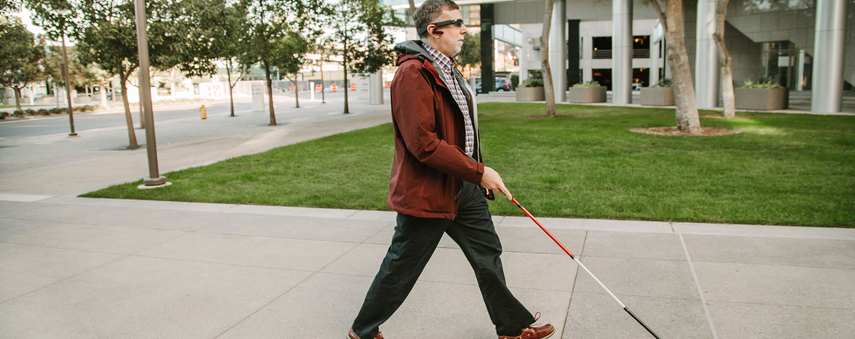AI is assisting the visually impaired with Aira technology

Credit: Aira
Aira connects people who are blind or have low vision to a combination of highly-trained and AI-powered human agents. We spoke to co-founder Sujeeth Kanuganti.
In 2014, Suman Kanuganti struck up a friendship with communications expert Matt Brock. Brock was blind and the pair’s conversations about the challenges of blindness gave Kanuganti the idea to develop technology to assist his friend’s condition.
A year later, Sujeeth Kanuganti and Watson Yim launched Aira, a service to connect those with poor vision to highly trained agents who can assist with their queries. At the touch of a button, Aira can deliver instant information to the visually impaired. This improves their independence and their efficiency at work or in education.
Aira has been extremely well received. Named by TIME Magazine as one of the Best Inventions of 2018 is offered as a monthly subscription direct to consumers but it is also available as a free service through its access network comprised of businesses, websites and digital products, retailers, airports, supermarket chains, campuses and sports venues.

“For us, it’s important to understand what our users – we call them Explorers – are calling about, automatically, so we can serve them better,” Sujeeth says. “AI lets us do that much more efficiently. So if an Explorer calls in about describing a game with the Denver Broncos, we can understand you are calling about American Football and hopefully have someone to assist you who understands that sport.”
How does Aira use AI?
Aira employs a number of technologies into one product. Its AI aspect is what connects an Explorer to the agent that they need to speak to.
“Some of the AI is closer to the user,” Sujeeth explains. “We have a dialogue engine called Chloe, still in its infancy, which converses with the user to finish simple tasks, like reading the instructions, documents, identifying products, etc.”
AI is just a tool. The real question to ask is, what is the problem we really want to solve?
Sujeeth Kanuganti, co-founder of Aira
The idea of Aira’s AI being in its infancy is one that Sujeeth believes is true for most companies. He compares artificial intelligence to a three-year-old at this point and acknowledges that despite the technology having roots in the 1950s, it’s only really been in the last decade that AI has accelerated. Sujeeth even believes that AI was “uncool” in the 1990s.
“The key challenges [for AI] will be converting research to products that actually work in the real world, getting datasets that reflect this real world without bias, getting more developers, students, designers and policymakers involved in the process of building AI,” he says. “In the end, AI is just a tool. The real question to ask is, what is the problem we really want to solve?”
In the case of Aira, the company uses artificial intelligence for computer vision and language processing.
“For computer vision tasks, we use Convolutional Neural Networks to understand the visual world,” Sujeeth says. “For Natural Language Processing we use BERT (Bidirectional Encoder Representations from Transformers) for understanding what the spoken text intends to mean, and understand the context. We also use topic modelling to understand the various tasks and sub tasks our users aim to finish.”
Aira uses augmented reality in its service
On top of artificial intelligence, Aira has dipped its toe into augmented reality. Aira is fully integrated into frames that increase GPS accuracy and augment a user’s walking experience with spatial audio feedback.
“Aira augments the reality of blind, which is lack of instant access to information, primarily based on visual intelligence in addition to contextual, powered by human visual objective descriptions with video and AI models,” says Sujeeth. “Aira immerses agents into [the] user environment is highly enhanced by augmenting video feed with user orientation and respective directional street view.”
“Aira is the AR for the blind and with the adoption of AI [and the] advent of high network bandwidth via 5G, we [will] see Aira being applied into other verticals seamlessly.”
The relatively short history of Aira as a company is about melding together technologies for an unbeatable service. Sujeeth says however that the future of the company is about human beings as much as it is about technology.
“As Aira moves forward, including bringing Aira technology and services to a growing cadre of blind and low-vision populations, [we want to] get Aira in hands of millions by expanding the Aira access network,” says Sujeeth. “By learning from the responses of our human Agents, [we will] train better AI technology to interact in tasks with users, via our autonomous agent, Chloe, as well as to assist human agents.”
Aira is an ambitious organisation. With a novel idea based on groundbreaking tech, the future looks bright for AI helping the visually impaired.